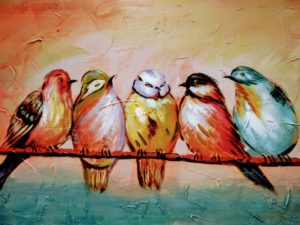Here are the following key factors to determine and feel your pet bird’s affection towards you.
You will often hear people say that they prefer keeping dogs or cats as pets because these can show their owners signs of affection. Animal experts say, though, that other animals have their own ways of showing their love. Here we give an insight into bird body language so you can tell if your pet thinks that you are the best thing since birdseed.
1. Look into his eyes. Birds can control their irises, enlarging and shrinking their pupils rapidly. This display is called ‘flashing’ or ‘pinning’; birds may do this when they are excited, greatly interested in something, or when they are angry, frightened, or aggressive. You have to take this into context and look into other cues to know if he is feeling frisky or threatened.
2. Bring on the noise. Here are some verbal cues that will let you know if your bird is one happy camper:

a. Chattering. Happy birds generally chatter (but remember, some bird breeds are silent so know whether this is true about your bird first). A soft chattering sound can be a sign of contentment. When your bird makes a louder chattering noise, it could mean that he is trying to get your attention, or remind you that there. In the wild, birds often chatter in the evening before going to sleep to connect with other members of the flock―sort of their way of telling the others how their day went at the office.
b. Talking or whistling. As in the human world, whistling is a sign of appreciation―note that what goes through their minds are much different from what a construction worker’s, though! In your bird’s case, these vocalizations are often signs of a happy, healthy, content animal. Some birds love an audience and sing, talk, and whistle the most when others are around. Other birds will remain quiet when they have an audience. Small birds such as budgies chirp it up when they are feeling happy.
c. Purring. This does not sound the same as a cat’s purr; a bird’s sounds are more like a soft growl. This can be a sign of either contentment or annoyance. When you hear him purr, you have to then take a moment to look at the other indicators to be sure about how the bird is feeling. If the purr seems more like a growl, it means that you need to back off as he is feeling aggressive.
d. Tongue-clicking. By clicking his tongue against his beak, your bird may be entertaining himself or asking to be petted or picked up (assuming your bird is the type that can and should be handled; again, you should know this about him first!).

e. Beak grinding. When you hear your bird grind his beak, it means he’s happy, contented, and relaxed.
3. Check the crest. Birds such as cockatoos and cockatiels have beautiful, expressive crests. A bird with his crest held back, with just the tip tilted up, is usually a picture of contentment. If he is happy to see you, he will often lift his crest.
4. Wing it. A bird flapping his wings may mean that he is trying to get your attention or displaying happiness; it can also be taken literally as him getting his exercise.
5. Tell tails. Just like a dog, a bird may wag his tail to tell you that he is glad to see you. There is another side to it, though; tail wagging can also be a sign that he is getting ready to poop. In any case, this sign is often helpful if you are trying to house-train your bird.
6. Let him spit it out. Regurgitation is the expulsion of contents from the mouth, esophagus, or crop (expanded, muscular pouch near the gullet or throat, often used to store food). If your bird pins his eyes, bobs his head, and stretches out his neck, then regurgitates his dinner… well, be happy instead of grossed out. He is simply showing you how much he loves and appreciates you. Reach for a tissue to wipe away your happy tears…then his mess.
7. Be a tree. Birds can be touchy-feely too. Once out of the cage, affectionate bigger birds like cockatiels will often fly to your shoulder to perch. Your cockatiel may also nibble at your jewelry or play with your hair. He may try to groom your eyebrows for you. This is the same behavior that birds can display with their mates. Birds can nip playfully, but as with any species, affection should never be painful.
This story appeared in Animal Scene’s March 2015 issue.






